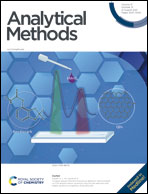A near-infrared fluorescent probe targeting mitochondria for sulfite detection and its application in food and biology†
Abstract
Sulfur dioxide (SO2) is the main air pollutant in the environment, causing great harm to human health. Abnormal SO2 levels are usually associated with some respiratory diseases, cardiovascular diseases, and neurological disorders (even brain cancer). Therefore, monitoring SO2 levels is helpful to better understand its special physiological and pathological role. Although many fluorescent probes for SO2 have been reported, many of them were not ideal for in vivo imaging due to the short emission wavelength. In this work, a near-infrared fluorescent probe NIR-BN with emission wavelength of 680 nm was constructed by conjugating the benzopyrylium moiety and 6-hydroxy-2-naphthaldehyde. NIR-BN had high selectivity and rapidity for SO2 detection. In addition, the detection limit of NIR-BN was relatively low, which can be used for the determination of sulfite in different sugar samples with high accuracy. Of course, due to the excellent spectral and structural properties of NIR-BN, we have applied NIR-BN to the detection of SO2 in biological systems.



 Please wait while we load your content...
Please wait while we load your content...